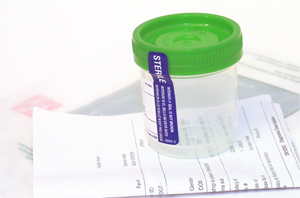The nonprofit trade association that administers the drug and alcohol testing compliance program for more than 400 vessel operators in the United States contends the Coast Guard’s new rules for random testing go too far and are unwarranted.
In the interest of safety of maritime workers, passengers, property and the environment, the Coast Guard requires random drug testing of crewmembers who perform safety-sensitive duties on commercial vessels. Marine employers are required to maintain a record of testing data for each calendar year.
At the start of 2019, the Coast Guard announced that the minimum random drug-testing rate would increase to 50 percent from 25 percent, where it had been for five years. The Coast Guard is required by law to set the rate at 50 percent when the positive rate for drug use is 1 percent or greater as reported by marine employers in the previous year.
Returning the rate to 50 percent “is a reasonable and necessary step to mitigate the growing risk of drug misuse,” said Patrick Mannion, manager of the Drug and Alcohol Prevention and Investigation Program at the Coast Guard’s Office of Investigations and Casualty Analysis.
But the president and general counsel for American Maritime Safety Inc. — a trade association that serves two-thirds of the U.S. maritime industry, administers the drug compliance program for its members and tracks those statistics in cooperation with the Coast Guard — said AMS records indicate the positive rate has not exceeded 1 percent.
Lee Seham said Coast Guard data is being skewed by “more seasonal, transient operations with a less veteran work force” where drug violations are more prevalent. In figuring out the 1 percent threshold, he said those numbers “should not be combined” with stats from his consortium — which includes passenger cruise lines, tugboat and barge companies, oil tanker operators, maritime colleges, marine pilot associations and others — and has an excellent compliance record.
“It’s frustrating to us. To double our costs is not warranted,” Seham said, noting that costs include not only drug testing and processing, but also mariners’ extra time in port and other expenses. Raising the random testing rate to greater than 25 percent should be left to individual employers to decide, he said.
Caitlyn Stewart, director of regulatory affairs for the American Waterways Operators, said that without knowing details of the drugs behind the recent increase in the positive rate, it’s impossible to say whether the opioid epidemic and the legalization of marijuana in some states have played a role. But she said the AWO, which represents the U.S. tugboat, towboat and barge industry, “is very concerned” by this development.
“The trend line is going in the wrong direction, which is worrisome not only in and of itself, but also because the Department of Transportation expanded its drug-testing panel to include semi-synthetic opioids last year, and it is very possible that the positive rate will increase as a result,” she said.
Stewart noted that “semi-synthetic opioid use may be legitimate, if the mariner can provide a valid prescription, or illegitimate.” She added that the AWO is committed to supporting members’ efforts to create drug-free workplaces by providing resources and forums for information sharing.
Mannion verified that 2018 was the first year in which semi-synthetic opioids — hydrocodone, hydromorphone, oxycodone and oxymorphone among them — were included in the DOT testing protocols.
“How that has affected the positivity rate is not yet known as marine employers have just begun to report” their 2018 drug data, he said. He estimated that the Coast Guard “will have a firm grasp of how opioids” have affected the maritime work force later this year.
Yet there are early reasons for concern. Medical laboratories approved to conduct the testing have presented their opioid data for the first half of 2018.
“The data is troublesome, as it indicates opioids have become the largest class of drugs producing a positive result at the laboratory,” Mannion said. “The laboratory positive result is then sent to a medical review officer, who will evaluate the results and will interview the mariner to identify the cause for the positive test result. The vast majority of those mariners will have a valid prescription for the use of those opioids, and the MRO is required to certify the results as negative.”
Sean Kline, director of maritime affairs for the Chamber of Shipping of America, said other factors can skew the data, including drug testing of potential employees “who never make it aboard ship,” and marijuana use detected a month after a mariner has been off duty for a long stretch.
Regardless, Kline said his organization’s members wholeheartedly support testing because they realize safety is of utmost importance.
“It’s a good thing,” he said. “It’s kind of a no-brainer.”

